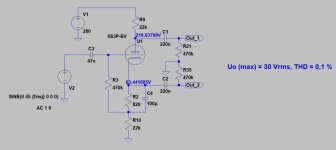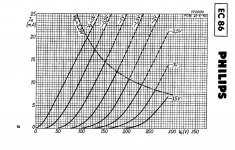The Russian 6S3P-EB tube seems to be a good candidate for Cathodyne PI. It has high gain and low plate operating voltage to allow direct connection. See charts attached.
However, I could not find any reference to this application. In fact, I can't find many applications for this tube on the Internet. Are there any reasons this tube is not popular for audio? Availability? Microphonic? Poor sounding?
However, I could not find any reference to this application. In fact, I can't find many applications for this tube on the Internet. Are there any reasons this tube is not popular for audio? Availability? Microphonic? Poor sounding?
Attachments
HI, artosalo, thanks for the reply. How about two tubes direct connected as Morgan Jones showed in his book? I assume we can get more gain than E88CC used in the Bevois Valley. I am not sure the THD will be better.
The Russian 6S3P-EB ... In fact, I can't find many applications for this tube on the Internet. Are there any reasons this tube is not popular for audio? Availability? Microphonic? Poor sounding?
maybe because its a single triode rather than a twin ... ?
incidentally, european type EC86 is the same tube, search for it ...
How about two tubes direct connected...
That is possible, but direct connected amp/cathodyne is a compromise because the voltage amplifying stage biases the phase inverter.
However it works fine if the output stage does not require very high drive voltage.
This could be one circuit to start with.
Attachments
incidentally, european type EC86 is the same tube, search for it ...
I wouldn't call them the same (pinout is different too).
Attachments
6S3P-EV has been used as input stage for RIAA phono preamps. Member kevinkr used it in the early iterations of his 'Muscovite' designs. Search for it...
Op wants:
RIAA does not help much for that need.6S3P Tube for cathodyne application
This is true.
However, you can see how that particular tube type has been used by someone who knows what they're doing.
Just data points to work from. That is all.
However, you can see how that particular tube type has been used by someone who knows what they're doing.
Just data points to work from. That is all.
The Russian 6S3P-EB tube seems to be a good candidate for Cathodyne PI. It has high gain and low plate operating voltage to allow direct connection. See charts attached.
However, I could not find any reference to this application. In fact, I can't find many applications for this tube on the Internet. Are there any reasons this tube is not popular for audio? Availability? Microphonic? Poor sounding?
6S3P (6S4P) is a great tube, not microphonic at all, great sound, long life and easy to supply. The difference between 6s3p and 6s4p is that 6s4p is designed for ground grid connection and has a different pin layout.
I used 6s4p with a grounded grid in I / V conversion in my DAC and as a cathode follower, sound much better than the ECC88 I used before. Now I use 6HM5 for I / V conversion.
A friend uses 6S3P in his phono preamp and I can only say that it sounds incredibly good, clean, noiseless, great dynamics. 6S3P (6S4P) likes slightly higher currents, from 10 to 15mA.
As a reference here is ac-couple version. With 280 V as +Ub it can deliver 1.5-times (30 Vrms) bigger drive voltage with lower THD.
Hi Artosalo, I set up a LTspice simulation on the suggested circuit. I got the same voltage and gain as yours. Looks like we used the same model.
However, the THD from my simulation is 0.557% instead of less than 0.1%. See attached. As I am not well versed in LTspice, I did my simulation at a fixed frequency of 1000 Hz. Can you please explain how did you get the less than 0.1% THD? Thanks.
Attachments
We used different tube model. Mine was 6S3P-EV:
.SUBCKT 6S3P-EV 1 2 3 ; P G C (Triode) 21-Sep-2007 by oleg_s
+ PARAMS: MU= 50.05 EX= 2.73 KG1=520.29 KP=1378.63
+ KVB=1378.63 VCT=0.00 RGI=1000
+ CCG=6.7P CGP=2.4P CCP=1.65P
E1 7 0 VALUE=
+{V(1,3)/KP*LN(1+EXP(KP*(1/MU+(V(2,3)+VCT)/SQRT(KVB+V(1,3)*V(1,3)))))}
RE1 7 0 1G
G1 1 3 VALUE={(PWR(V(7),EX)+PWRS(V(7),EX))/KG1}
RCP 1 3 1G ; TO AVOID FLOATING NODES IN MU-FOLLOWER
C1 2 3 {CCG} ; CATHODE-GRID;
C2 2 1 {CGP} ; GRID-PLATE;
C3 1 3 {CCP} ; CATHODE-PLATE;
D3 5 3 DX ; FOR GRID CURRENT
R1 2 5 {RGI} ; FOR GRID CURRENT
.MODEL DX D(IS=1N RS=1 CJO=10PF TT=1N)
.ENDS
Anyhow, the simulated THD is often indicative, not accurate.
.SUBCKT 6S3P-EV 1 2 3 ; P G C (Triode) 21-Sep-2007 by oleg_s
+ PARAMS: MU= 50.05 EX= 2.73 KG1=520.29 KP=1378.63
+ KVB=1378.63 VCT=0.00 RGI=1000
+ CCG=6.7P CGP=2.4P CCP=1.65P
E1 7 0 VALUE=
+{V(1,3)/KP*LN(1+EXP(KP*(1/MU+(V(2,3)+VCT)/SQRT(KVB+V(1,3)*V(1,3)))))}
RE1 7 0 1G
G1 1 3 VALUE={(PWR(V(7),EX)+PWRS(V(7),EX))/KG1}
RCP 1 3 1G ; TO AVOID FLOATING NODES IN MU-FOLLOWER
C1 2 3 {CCG} ; CATHODE-GRID;
C2 2 1 {CGP} ; GRID-PLATE;
C3 1 3 {CCP} ; CATHODE-PLATE;
D3 5 3 DX ; FOR GRID CURRENT
R1 2 5 {RGI} ; FOR GRID CURRENT
.MODEL DX D(IS=1N RS=1 CJO=10PF TT=1N)
.ENDS
Anyhow, the simulated THD is often indicative, not accurate.
After I reduced the maximum time step to the same value as yours, I got the same results. I have to admit that I don't understand the reasons for the change. Thanks for the support!
Just be aware of the filament to cathode insulation ratings, I have violated them (filament positive in reference to cathode) without difficulty in the 6S3P, but not by more than 50V or so.
Note that the 6S3P and 6S4P are different in this regard. I currently use 6S3P on the bottom and 6S4P on the top to avoid violating the requirement, but never had a 6S3P fail for this reason in older ones that were all 6S3P.
I still use the 6S3P and 6S4P as cascode input stage of my Muscovite phono pre-amplifier designs.
Voltage swing is somewhat limited, although I have not run up against this in RIAA or line level applications. Likely fine for EL84 and EL34 amps.
They are quiet and very, very linear at the low levels I use them at.
Note that the 6S3P and 6S4P are different in this regard. I currently use 6S3P on the bottom and 6S4P on the top to avoid violating the requirement, but never had a 6S3P fail for this reason in older ones that were all 6S3P.
I still use the 6S3P and 6S4P as cascode input stage of my Muscovite phono pre-amplifier designs.
Voltage swing is somewhat limited, although I have not run up against this in RIAA or line level applications. Likely fine for EL84 and EL34 amps.
They are quiet and very, very linear at the low levels I use them at.
- Home
- Amplifiers
- Tubes / Valves
- 6S3P Tube for cathodyne application







